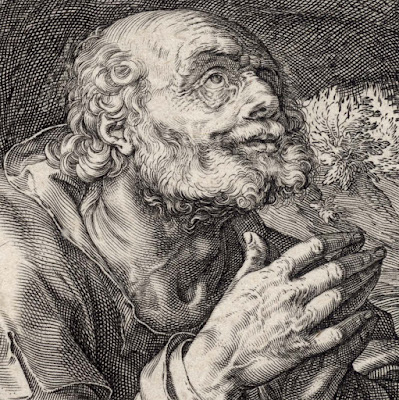Hendrik Goltzius (1558–1617)
“Saint Peter”,
1589
Plate 1 from
the series of fourteen small plates: “Christ, the Twelve Apostles and Paul”
(see New Hollstein 35-48).
Engraving on
fine laid paper trimmed to the image borderline and without the lines of text.
Size (sheet) 20
x 12.8 cm; (plate) 12 x 10 cm (text line removed)
Inscribed
(towards the lower-left corner): "HGoltzius inuen / et sculptor A.o
1589"
The state of
the impression is unknown as the text lines are missing which would have revealed
this information (e.g. state iii has two sets of numbers within the text box).
Nevertheless, as this is such a crisp impression showing very little wear it is more than likely to be a lifetime impression.
The British
Museum offers the following description and information about this print:
“Plate 1: St
Peter. Half-length and turned to right, hands clasped in prayer, two crossed
keys and a book (Scriptures) in front of him …” (http://www.britishmuseum.org/research/collection_online/collection_object_details.aspx?objectId=3036307&partId=1&searchText=goltzius+apostles&page=1)
Hirschmann 35;
New Hollstein (Dutch & Flemish) 35.I (Hendrick Goltzius); Hollstein 35.III;
Bartsch III.24.44 (These references are those given by the British Museum for a
third state impression)
Condition:
strong and crisp impression, cut above the text lines and lined onto a
conservator’s support sheet. There is a small loss with restoration at the
upper-left and upper-right corners.
I am selling
this famous and original Goltzius engraving for the total cost of AU$268
(currently US$195.64/EUR187.44/GBP156.78 at the time of this listing) including
postage and handling to anywhere in the world.
If you are
interested in purchasing this marvellously crisp impression of St Peter with his keys to Heaven, please contact me
(oz_jim@printsandprinciples.com) and I will send you a PayPal invoice to make
the payment easy.
This print has been sold
The gift that Goltzius bequeathed to the world is his famous “dotted lozenge” (i.e. a drawing
technique whereby a dot is placed in the diamond/lozenge shape created between
cross-hatched lines). This simple technique gave generations of illustrators a subtle
way to render tonal gradations so that shading from light to dark
could be portrayed almost seamlessly.
When I look at
an engraving like this (and the small size of the print needs to be taken into
account) I am in awe of the skill displayed. Of course Goltzius must have
been passionate about his craft to devote so much time and discipline into an
engraving such as this, but I need to propose that there is another factor in
understanding Goltzius’ ability that I have never seen writers discuss:
Goltzius’ deformed hand and how well his engraving tool (the burin) fitted his
hand.
My understanding
of the tragic circumstance that led to Goltzius’ hand to being deformed into an
ideal shape to control the engraver’s burin was that he fell into a fire when
he was a toddler and the badly burnt hand was bound in cloth as a way of attending
to the burn. Sadly, the tight binding of the hand left Goltzius with a
permanent deformation. Although I may be misguided to believe that this
particular deformation “helped” Goltzius to control the burin by the burin
fitting perfectly within the shape of his hand and arguably avoid the debilitating
affects arising from continuous pressure on the wrist—e.g. Tendinopathy (tendon
injury), RSI (repetitive strain injury) and Carpel Tunnel Syndrome (compression
of the median nerve)—it certainly did not hinder him.
An interesting
aspect of Goltzius’ deformed hand is that he used it as a model for many of the
apostles’ hands shown in the series that this print is a part. Again, my belief
that his hand was used as a model may be incorrect, but looking at Goltzius’
very famous pen drawing of his hand shown in the sanguine image above and the right
hand of St Peter I can see clear similarities. (Note: Goltzius’ pen and ink
drawing of his hand, which emulates the line attributes of an engraving, is in
the collection of the Teyler Museum in Haarlem.)








No comments:
Post a Comment
Please let me know your thoughts, advice about inaccuracies (including typos) and additional information that you would like to add to any post.